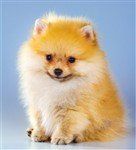Pomeranian Nose Colors - Beaver, Parti, Dudley, Spotted and Newborn
Overview
This is a continuation of our Pomeranian Nose Color article. We have already covered an overview of noses, which colors are accepted, examples and explanations of black, blue, lavender and chocolate. So, if you wish to read about those elements, do be sure to check out Page 1 of Pomeranian Nose Colors, Black, Blue, Lavender and Chocolate.
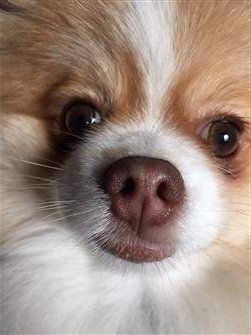
Beaver Noses with the Pomeranian Breed
Beaver is a dilute chocolate. This particular color exists in many other dog breeds, though it is often dubbed liver. Since beaver is a dilution gene that affects both coat and skin pigmentation, if two Pomeranians carry just 1 dilute gene each, they can produce puppies that hold 2, and therefore outwardly show this.
Beaver is a common nose color for Pomeranians. This said, there is a wide range of tones to beaver, ranging from very light to very dark. In many cases, a beaver nose will be so dark that it may appear to be chocolate however it will have a purple sheen to it; those who are familiar with this breed will be able to know the color by looking at both the coat and, importantly, the eye rims of the Pom. On the flip side of this, many beaver colored noses are very light and due to the unique shine and sheen of this hue, the nose will appear to be pink.
Photo (above on mobile): An adorable Beaver nose. It is classified as beaver and not chocolate, due to the lack of chocolate on the coat.
Rupaul, 4 years old, Photo courtesy of Pamela Sebedra
Dark Beaver Noses
With beaver colored noses, the beaver can be just about as dark as chocolate, however you can usually know it is beaver by looking at the coat (no dark brown) and the eye rims may lean more toward a moderate beaver hue.

This is a very uniquely colored Pomeranian - a beaver parti
merle. First, we have the dark beaver nose. Then, as you can see the beaver is so strong, the color carries to the muzzle and the beaver eye rims encase light blue eyes (the blue eyes tell us the merle gene is there, even though it does not show on the coat)
Kody Bear - 21 months old - Marilyn Wetter

With just about the same deep dark beaver color on the nose as the previous Pom, this is a slightly lighter shade. Though lips and eye rims are beaver, just a bit of that hue is seen on the muzzle, both above and below.
Abby, 2 years old
Photo courtesy of Belinda Hood

This little camera-shy cutie has a dark beaver nose. We love this color, because as you can see it is so close to a dark purple. So pretty!
Charlie Joe, 4 years old
Photo courtesy of Megan Blazer
Pomeranians with Beaver Noses
These are a more 'classic' beaver color, though any range (light to dark) is accepted. Again, as with dark beaver, you know it is a beaver nose and not chocolate because there is no dark brown in the coat. Many coats will be cream and beaver, sometimes with just a bit of highlighting and sometimes as an obvious secondary color.

Often, when one mentions a beaver nose, this is the image that comes to mind. This Pom's nose is a classic beaver color and it's easy to see that the eye rims match. Louie Vuitton
Photo courtesy of Terry Feathers

Both of these little ones are cutie pies! This is another classic medium beaver nosed Pom.
Bunny, Photo courtesy of Jennifer Parkhurst

The beaver nose and eye rims complement the soft tans and creams in the coat of the Pomeranian.
Mac, 12 years old
Photo courtesy of Michelle Rhineberger

A cute beaver nosed Pom (also referred to a light brown).
Chloe, 7 years old
Photo courtesy of Karen Hardy

A 'perfect' beaver colored nose, with matching lips and eye rims.
Cooper, 4 years old
Photo courtesy of Lisa Olney
Next up...
Two-Toned Noses (parti)
There are 3 very
different reasons why a Pomeranian can have a two-toned nose, in other words a black and pink nose or a brown and pink nose. In rare cases, this will also be applicable to a black and brown nose or another two color combination.
1. If the Pom has merle
in him/her, the merle gene can (and often does) affect the nose. Merle 'splatters' coloring, so that does
often show up on the nose and also the eyes (blue eyes or odd eyes (each is a different color).
2. If the Pomeranian is a parti with white (also known as 'white parti factored'; 2 colors and one is white)...
... the parti gene can affect the nose, making it two colors as well. Even just a dash of white means that the parti gene is at play. If the Pom has parti in the bloodline, but the parti is not showing, a parti nose is a mis-mark.
3. Discoloration.
When the nose becomes discolored, this is often referred to as a dudley nose. It is also called 'winter nose' or 'summer nose', though it can stay pink all year-round. This can throw a lot of owners off, who assume that the pink on the nose is natural coloring. However, without any merle or parti in the genes, loss of pigmentation is often the reason for the two-toned nose.
What can make this happen?
Nose discoloration is generally caused by one or more of the following 3 things (and each can be reversed):

Tinkerbell, 3 years old
Photo courtesy of the Gentry Family

This Pom's nose had us puzzled for a bit. The nose tells us 'chocolate', but
the coat is borderline and ultimately cannot be ruled a chocolate.
The two-tone of the nose, however, is due to the white parti factor. We have decided to categorize the nose as a beaver parti nose, and it is VERY unique!
Bentley, 9 months old, Photo courtesy of Cherie von Kanel
- Not enough sunshine- It is not uncommon for noses to darken in the summer and lighten in the winter, however some Pomeranians will have year-round dudley noses still due (in part or in whole) to lack of sunlight. Some Poms are just less responsive to the sun than others, so this does not necessarily mean that the owners are not exercising the Pom enough, it may just mean that the dog needs more sunshine exposure than normal. There can be elements that come into play such as owners only being able to walk the dog in the early morning and late evening when the sun is very low in the sky and perhaps not enough playtime outside on sunny days.
- Plastic food and/or water bowls
- This is becoming a less frequent reason for noses that turn pink, mostly in part to more owners being aware of the issues surrounding plastic dog bowls.
- Lack of vitamins and minerals
- It is not yet clear exactly which vitamin, mineral or combination of these can lead to loss of nose pigmentation, however if the sun and bowl issues are resolved without changes seen, making sure that the Pomeranian is eating only high-quality food and in some cases being given a full & complete canine vitamin and mineral supplement, can revert the nose back to black.
What to know about black and pink noses - If a Pomeranian has a two-colored nose due to genetics, though not 'accepted' in show, there is nothing at all 'wrong' with this and is in fact, a charming trait that gives the dog a unique look. This said, it is a fault in show and those Poms will be considered pet Poms and should not be bred, as this show fault can be passed down.
Figuring out the difference- If the black and pink nose is due to merle or white parti factor, the Pom's the two-toned nose will be present at birth (or soon afterward as spots start to appear while a newborn, more ahead).
If you see merle in the coat (or know it is in the bloodline - a Pom can be a 'hidden' merle) or if the Pom is parti (and white is one of the colors, even if it is a very small amount of white), this tells you that the pink is natural.
If, on the other hand, the Pom has no merle or parti (outwardly or in the bloodline) and the nose started to change colors (many owners do not notice, until they go back and look at photos taken over the course of years), this then points to an unnatural discoloration to the nose that can often be reversed.
To help a pink nose turn back to black, if the nose is pink due to loss of pigment or discoloration, you can 1) Increase the duration that the Pom is outside (take him for an extra walk and/or play outside in the yard daily. Just adding on 20 to 30 minutes per day can make a difference. You may start to see changes after 6 to 8 weeks. 2) If you use plastic bowls, switch to stainless steel and 3) Reassess main meals and snacks and speak to your vet about offering a canine vitamin and mineral supplement.
Pomeranian Black and Pink Noses (and two-tone brown)
Let's look at a great sampling of some two-tone Pomeranian noses:

Maximus Hau Kea Kaupili, 1 year old, nose is parti due to parti factor gene
Photo courtesy of Dr. Rocelle Maliksi

White, with possibly beaver parti genes at play, making the nose spotted due to that parti gene.
Sidney, 8 years old
Photo courtesy of Kelly Sham
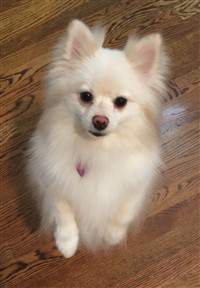
A white parti-factor Pomeranian with a black and pink nose.
Fiona Snow, 2 years old
Photo courtesy of Audrey

A parti-white Pom, the parti has landed on the nose, making it naturally black and pink.
Bailey, 7 months old
Photo courtesy of Vanessa

A two-tone beaver nose on this princess.
Audrey, 6 years old Photo courtesy of Jeff & Lucy Thornton

You may have noticed by now, how similar these Poms are, almost looking like brothers and sisters! Many with lots of white in the coat and black and pink noses... This Pom, like the others, is an extreme piebald parti (much more white than any other color), and that strong parti gene landed on the nose, making the nose two different colors.
Packer,
Photo courtesy of Amber Davis

With this Pom, it is tricky! The chocolate in the coat tell us that the nose may be chocolate, however
the eye rims suggest beaver. The nose, as you can see, holds two colors. We believe that this is due to white parti factor (white seen on muzzle). This is one of the situations where you just have to make an educated guess, and therefore we are classifying the nose as chocolate parti factored. Gatchan, 5 months old, Photo courtesy of Sitas Manusphaibool
Pomeranian Spotted Noses
When a nose is literally spotted, this is due to the merle gene (barring any sort of damage or discoloring). The merle gene causes color to splatter. It can land anywhere. It may or may not land on the nose; when it does, the Pomeranian's nose will be spotted (think tie-dyed). If it lands in the eyes, you can get blue eyes or odd-eyes (each is a different hue)
If you have a Pom with a spotted nose but you do not see any merle on the coat, this can point to that dog being a 'hidden' or 'phantom' merle, which means that the gene is carried by the dog. This little cutie is a merle with a merle spotted nose, photo courtesy of Lora of Pomarazzi Pomeranians.
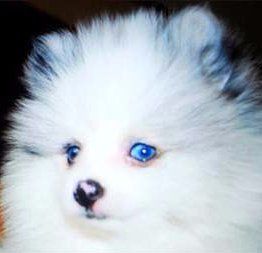
Pomeranian Newborn Puppy Noses
Pomeranian puppies are born with either colored noses (black, chocolate, beaver, blue) or pink noses. And there is no official number or percentage on this. We polled our Personally Recommended Pom Breeders
on this subject. It must be noted that if a breeder focuses on certain colors, they will have more pups of either colored or pink noses. When asking the percentage of newborn Poms having a colored nose or
a pink nose, the answers were: 70/30, 50/50, 60/40, 50/50, 70/30, 80/20, 75/25 and 60/40.
Puppy Nose Facts
- If a Pomeranian puppy's nose is pink at birth, it may change to a solid colored nose, a two-colored nose or a spotted nose.
- If there the merle gene is at play, it may change to a two-colored or spotted nose. The merle gene never lands the same twice, so you simply cannot predict if it will land on the nose.
- If the parti gene is at play, it may become a two-toned nose, as seen in the above photos, though this is not always the case.
- If it happens, the color change on the nose typically occurs between the early age of 2 and 4 weeks old. There can be changes up until around the 4 month mark... and in rare cases, much later than this.
- If a Pom puppy is born with a solid colored nose and as he matures it turns pink, this is often due to the factors previously mentioned of: sunlight, bowls and/or vitamins.
Now, Let's Look at some Examples of the Nose Color Changes of Newborn Poms
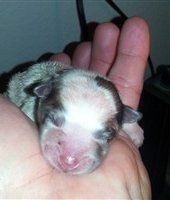
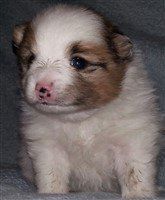
Nose Develops Spotting
- This is the same Pomeranian puppy, Uno, as a newborn (1st pic) and then as a 5 week old (2nd pic). The dam is a red sable
parti and the sire is a blue merle extreme piebald. Due to the extreme piebald, most likely the nose will not fill in and will remain two-toned. Extreme piebald is a term that means two-toned, with much more white than another color (about 80/20). Photos courtesy of Brenda Moening from Las Vegas Nevada
Nose Turns From Pink to Black
Here, we see a sable parti Pomeranian puppy as a days-old newborn (1st pic) with a bright pink nose! Note how cute those pink paws and inner ears look too! Now, look at the same puppy at 8 weeks old (2nd pic), the nose has turned completely black, and what a gorgeous puppy this is!
Photos courtesy of Lora, of Pomarazzi Pomeranians


Nose Change After the 8 Week Mark
As mentioned previously, most nose color changes take place before you bring your new puppy home, though changes to the nose can occur as late as 4 months old. And keeping that in mind, we have a nice little surprise for you here (All photos below courtesy of Pomarazzi Poms)
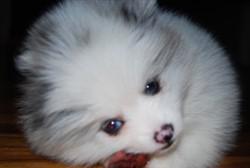
First take a look at this Merle parti, Angel, at 8 weeks old... The nose is about 50/50 black and pink.
Next, you'll see Angel at 12 weeks old, the nose has now changed to about 80/20...

So, this spotted nose is completely expected, since the merle gene is a spotting gene and it can land on the nose, causing it to be pink with black spots...
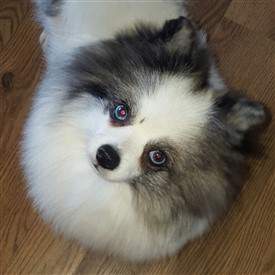
You would think that it would end there...but here is Angel at 4 years old. Her nose is completely
black & the dark fur really intensified.
We want to give a huge thank you
to Carol of Keen Pomeranians, one of the most
knowledgeable, reputable and loving breeders that we know. She was invaluable to us in identifying all of the noses colors. Thanks Carol!
Did you enjoy this section about noses?
If so, you should check out what's in the PetPom Book! It's the website times 100~! Available in both print and eBook, it is the most comprehensive Pomeranian care book in the world.
Things to Do Now:
Become a Free PetPom Member
(if you are not already a Member) so that you'll receive a friendly reminder when we add a new Topic of the Month to this Pomeranian blog & when we add new pages and sections to the site! You will also receive a fun & helpful Welcome Booklet.

